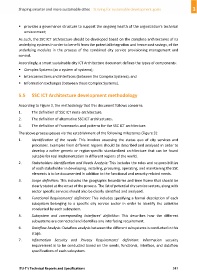Page 357 - Shaping smarter and more sustainable cities - Striving for sustainable development goals
P. 357
provides a governance structure to support the ongoing health of the organization's technical
environment;
As such, the SSC ICT architecture should be developed based on the complete architectures of its
underlying systems in order to benefit from the potential integration and hence cost savings, of the
underlying modules in the process of the combined city service provisioning management and
control.
Accordingly, a smart sustainable city ICT Architecture document defines the types of components:
Complex Systems (as a system of systems);
Interconnections and Interfaces (between the Complex Systems); and
Information Exchanges (between these Complex Systems).
5.5 SSC ICT Architecture development methodology
According to Figure 2, the methodology that this document follows concerns:
1. The definition of SSC ICT meta‐architecture.
2. The definition of alternative SSC ICT architectures.
3. The definition of frameworks and patterns for the SSC ICT architecture.
The above process passes via the establishment of the following milestones (Figure 3):
1. Identification of the needs: This involves assessing the status quo of city services and
processes. Examples from different regions should be described and analyzed in order to
develop a rather generic or region‐specific standardized architecture that can be found
suitable for real implementation in different regions of the world.
2. Stakeholders Identification and Needs Analysis: This includes the roles and responsibilities
of each stakeholder in developing, installing, procuring, operating, and maintaining the SSC
elements is to be documented in addition to the functional and security related needs.
3. Scope definition: This includes the geographic boundaries and time frame that should be
clearly stated at the onset of the process. The list of potential city service sectors, along with
sector specific services should also be clearly identified and analyzed.
4. Functional Requirements' definition: This includes specifying a formal description of each
subsystem belonging to a specific city service sector in order to identify the activities
conducted by each subsystem.
5. Subsystem and corresponding Interfaces' definition: This describes how the different
subsystems are connected and identifies any interfacing requirement.
6. Dataflow Analysis: Dataflow analysis between the different subsystems is conducted in this
stage.
7. Information Security and Privacy Requirements' definition: Information security
requirement is to be conducted based on the needs, functional, interface, and dataflow
specifications of each subsystem.
ITU‐T's Technical Reports and Specifications 347

